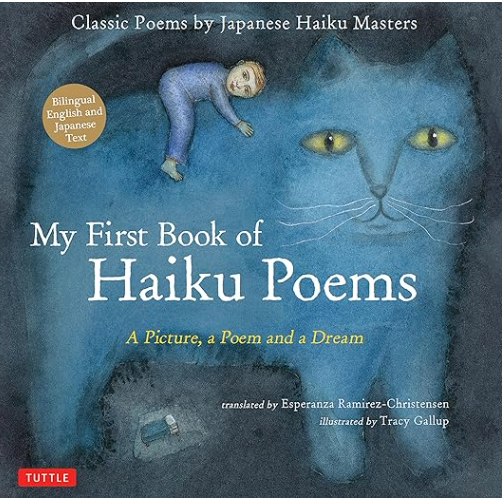What It’s Really Like to Learn with Disney Homeschool Curriculum
From Haikus to the Shaman of Songs: A Nature-Inspired Learning Unit
This past week, we dove into a cross-curricular unit that started with biology and some physics, and then we landed in poetry. Once there, we wandered through Japanese culture, and jumped back to Pandora, wrapping up with a glowing boat ride beneath bioluminescent trees.
It was the kind of week that reminded me why we homeschool in the first place: not just to check boxes, but to let learning do its thing while we live. It’s natural to learn and to follow our curiosities.
We used a portion of my Animal Kingdom Pandora Unit as our base. The unit is designed to explore the Na’vi culture and the interconnectedness of life on Pandora, which offered the perfect jumping-off point for a study on haikus.
A Gentle Introduction to Poetry
We began with My First Book of Haiku Poems: A Picture, a Poem and a Dream. Don’t let the title fool you! While it’s marketed toward young readers, this book is a treasure for all ages. As someone who majored in English in college, I found myself smiling with each poem, each brushstroke of illustration.
The book presents traditional Japanese haikus written by the masters (Bashō, Issa, Buson) alongside visual illustrations and translations in English, Japanese, and full Japanese script (kanji, hiragana, and katakana). The immersive nature of it was breathtaking. One idea, one moment in nature, offered in three languages, layered with art. It was exactly the kind of learning I try to create for my daughter: something memorable, multi-sensory, and meaningful.
Writing Her Own Haiku
After reading through the collection and talking about the structure of a haiku (three lines, 5–7–5 syllables), my daughter was eager to try one of her own. We had just returned from a beach trip, and the connectedness with nature had left a deep impression on her (quite literally, as we still have sand all throughout the car).
She drafted this:
The waves touch the sand
Moonlight makes a home at sea
Silly glowing fish
I watched her tilt her head, considering each line, counting syllables with her fingers ( still do this, too). She later illustrated the poem with the soft colors of a beach at night. The result was awesome: a finished piece I knew we’d add to her portfolio.
Taking It Further: Language Immersion
It would have been easy to stop there, but because we homeschool, and because I like to take things just one step further, we brought the Na’vi language into our poetry study.
In the Pandora unit, we explore the planet of Pandora, so I decided to bring in the language. My daughter and I looked up key Na’vi vocabulary and translated her haiku. Was it a perfect, grammatically flawless translation? Probably not, but what Na’vi is going to grade it? (Slightly geeky side note: Na’vis definitely wouldn’t grade). But it wasn’t about perfection. It was about engagement, experimentation, and honoring language as a tool for connection.
She wrote her poem again, this time with the Na’vi words handwritten beneath the English. Seeing it together was striking. One small poem, told two ways, now connected her to both the natural world and the fictional language of Pandora.
From Page to Park
To finish the project, we visited Animal Kingdom and rode the Na’vi River Journey. I had prepped her to listen closely to the music, to the intonations of the language, especially during the Shaman of Songs’ scene. Sitting next to her in the slow-moving boat, I watched her close her eyes and take it all in. Something else fun to watch on that ride? Look up.
The ride felt like a culmination… not a reward, exactly, but a reflection. Her artwork, her effort, and her curiosity had a real-world, sensory conclusion. We are BIG on adding those sensory elements.
If we weren’t visiting the parks that week, we would have watched Avatar or listened to some Na’vi conversations on YouTube. There are always ways to adapt.
The Piece That Made the Wall Street Journal
That illustrated poem (written in the homeschool room after spending a few days in southern Florida, translated at the kitchen table while debating over pronunciations, and connected to a fictional world that somehow teaches very real lessons about nature) was the work featured in the Wall Street Journal online today (and the print edition tomorrow!).
It was a quiet, lovely moment turned into something bigger than us. And I am so honored that our family’s experience with homeschooling, with immersive learning, and with creativity was included in that story.
Final Thoughts
What I hope people take away is this: homeschooling doesn’t have to look one way. Sometimes it’s worksheets and math drills. Sometimes it’s poetry and boat rides. Sometimes it’s translating moonlight into an alien language because your daughter can’t stop thinking about it.
I’m grateful to the Wall Street Journal for shining a light on the many ways families are learning outside the traditional classroom. And I’m also grateful for weeks like this, when I get to watch learning come alive in my daughter’s eyes.
If you're interested in the full Pandora-themed unit we used, you can find it here. It includes everything from biology to physics to language activities (just like this one).
And if you’re just starting out with Disney homeschooling or any type of homeschooling: welcome. There’s no right way to do this, but there are so many beautiful ways to make it your own.
Blog Posts You Might Also Enjoy
Looking for more ways to bring learning to life through Disney? Here are a few blog posts that build on the same spirit of creativity, culture, and connection that shaped our haiku project:
Think Like an Imagineer
This post explores how homeschoolers can “think like an Imagineer” by using curiosity, creativity, and problem-solving to design their own Disney-inspired projects and learning experiences.Top 10 Educational Shows on Disney+ Every Homeschool Family Should Watch
Discover shows that spark curiosity, connect to your curriculum, and inspire project-based learning—perfect to pair with your own themed units.How to Teach Art and Perspective at Disney’s Magic Kingdom (Main Street U.S.A.)
Bring artistic techniques into your next park day or living room. This guide blends observation, perspective drawing, and history into a fun visual lesson (FREE PRINTABLE).Mexico at EPCOT: Culture, Language, and Hands-On Learning
From ancient civilizations to caves, this cultural study at EPCOT’s Mexico Pavilion connects language, geography, and visual storytelling.Let’s Talk About Castles
This post dives into the real history behind Disney castles, how they inspire storytelling and imagination, and includes a free printable to help kids think about originality.











